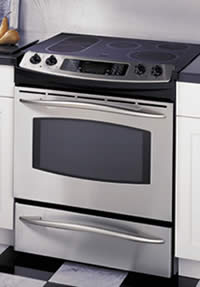Difference between Microwave and Conventional Oven
Key Difference: A microwave oven is a type of oven that uses microwaves to heat up food. Microwaves are a type of electromagnetic wave that is sandwiched between radio wave and infrared radiation on the electromagnetic spectrum. Conventional ovens are basically ovens that use gas, wood or electricity for power. These are ovens that we often find in many homes that are used for cooking.
Ovens have been in existence since the discovery of fire. They play an important part to our livelihood and well-being. There are various different kinds of ovens that are available in the market that makes it easier to cook, heat up food and various other things. Ovens are also used for other purposes such as glass-making, forging, ceramic making, creating heat, etc. Microwaves and conventional ovens are actually two different things. Conventional ovens are the traditional ovens that use fire, gas, electric to cook the food, while microwave ovens use microwaves to prepare the food.
 A microwave oven is a type of oven that uses microwaves to heat up food. Microwaves are a type of electromagnetic wave that is sandwiched between radio wave and infrared radiation on the electromagnetic spectrum and their frequencies range between 300 MHz (0.3 GHz) and 300 GHz. An interesting property of microwaves in this frequency is that they are absorbed by water, fats and sugars. However, they are not absorbed by plastic or metal. The microwave ovens run purely on electricity and do not require any additional set-up. It’s sort of plug-and-use equipment.
A microwave oven is a type of oven that uses microwaves to heat up food. Microwaves are a type of electromagnetic wave that is sandwiched between radio wave and infrared radiation on the electromagnetic spectrum and their frequencies range between 300 MHz (0.3 GHz) and 300 GHz. An interesting property of microwaves in this frequency is that they are absorbed by water, fats and sugars. However, they are not absorbed by plastic or metal. The microwave ovens run purely on electricity and do not require any additional set-up. It’s sort of plug-and-use equipment.
The first microwaves were invented following the World War II, using the radar technology that was developed during the war by Percy Spencer. The first microwave was named the ‘Radarange’ and was marketed in 1947 by Raytheon. However, at this time the technology was not yet perfected and the range was too huge to be used in homes and was only available for commercial purchase. It also required massive amounts of electricity to power, making it expensive to use. The modern microwave that we use, known as the countertop microwave’ was first developed in 1967 by the Amana Corporation, which was later acquired by the Raytheon.
Let’s try to simplify how the microwave oven actually works. When the food is place inside the microwave oven, the oven throws microwaves at the food. The microwaves are absorbed by the food, which is then turned into heat. Ever heard that microwaves heat the food from the inside out? Well, that is actually true. The waves that are absorbed by the fat, water and other substances inside the food start heating up the molecules of the food, the heat then travels outward, heating up the rest of the food. Notice, sometimes when frozen food is placed to heat in the microwave and it is not heated for a longer period of time, the inside will be warm, but the outsides are cold. That is because the heat has not yet travelled outside. The microwaves are not absorbed by plastic, glass, ceramic and metal. Metal actually reflects the microwaves; hence the internal lining of the microwave oven is made of metal. However, when you try to heat or cook food in metal pan, it basically just reflects the waves away from the food.
Microwaves are simple and efficient to use as they are portable, do not require any additional set up. They also save a lot of energy by heating up food faster compared to traditional ovens and stoves. They are also cost efficient during set up as well as in the long run. This is why is one of the must have appliance in many kitchens. However, when it comes to doing special cooking work such as baking, roasting or trying to make a crispy crust, microwaves are ineffective. For such, either special equipment such as waxing paper, or oiled pans, etc. must be used to cook these foods effectively or other conventional ovens can be used.
 Conventional ovens does not have a proper set definition, still it is found in many food packages that require to be heated in the ovens. Ever notice the ‘Use in Conventional oven’ or ‘Conventional oven only’ on the package of a food product. Well, conventional ovens are the traditional gas, stove and electric ovens that are found in everyone’s kitchen. These ovens are often huge and some may even come attached with a stove. These ovens are used for cooking, roasting and heating. Foods that are cooked in conventional ovens include meat, casseroles, lasagna, baked products (bread, cake, cookies, cupcakes, etc.)
Conventional ovens does not have a proper set definition, still it is found in many food packages that require to be heated in the ovens. Ever notice the ‘Use in Conventional oven’ or ‘Conventional oven only’ on the package of a food product. Well, conventional ovens are the traditional gas, stove and electric ovens that are found in everyone’s kitchen. These ovens are often huge and some may even come attached with a stove. These ovens are used for cooking, roasting and heating. Foods that are cooked in conventional ovens include meat, casseroles, lasagna, baked products (bread, cake, cookies, cupcakes, etc.)
Conventional ovens can or cannot be controlled depending on the complexity or simplicity of the oven. Simple ovens may not have any other controls other than on and off, with a timer. More complex ovens are available with timers, temperature controls, special modes for different types of cooking, and automatic off feature. These vary depending on the make and the type of oven that is available. Conventional ovens provide the heat for cooking from below, while the more new ones also provide heat from the top. However, one main difference that sets conventional ovens apart is that it is not have fans. This is considered one of the biggest differences from convection ovens. Convections ovens have fans to properly regulate temperature and properly distribute heat. Conventional ovens lack this feature; however, they are considered the best appliance for baking and broiling.
|
|
Microwave |
Conventional Oven |
|
Runs on |
Runs on electricity |
Electricity, natural gas (propane, butane, LPG), wood, etc. |
|
Price |
The price of the oven is quite economical. It does not require extra set up charges. |
The price of the oven depends on initial set up charges and what it runs on. |
|
Heating |
Heating is the fastest of all ovens. |
Heating depends on the type of oven. While gas ovens heat up fast, electric ovens take a while in order to heat up. |
|
Cooking Time |
Microwave ovens take the least amount of time to heat up food. It can also cook food under 5 minutes. |
Cooking time is greater in conventional ovens. |
|
Economical |
Microwave is very economical. It works on electricity and only consumes power when heating up food. It does not require any additional power. |
Again the economic factor depends on the type of ovens. Gas ovens are commonly more economic in the long run. Electric ovens are more costly in the long run as electricity is more costly compared to natural gas. |
|
Heat distribution |
Microwaves distribute heat more evenly as the food absorbs the microwaves and then turn them into heat. Heating may not be so even in thick, dense objects. |
Gas ovens distribute heat unevenly (more heat from top), while electric ovens have a more even heat distribution. |
|
Temperature Management |
Temperature is managed automatically. However, depending on the make, the microwave may allow the owner to change the temperature. |
Temperature is fairly to manage in almost all off the ovens. |
|
Burners |
No burners are required, only an electrical switch. |
Runs on burners, coils, wood, coal, etc. |
|
Benefits |
Microwave ovens are cheap, effective and simple to use. They do not require professional set up, they can be set anywhere on a counter top and plugged in. They also use less power and energy to heat up food. |
The benefit of each oven depends on the type of oven it is. While electric ovens are easier to clean and cheaper to install; gas ovens are faster to heat up and are cheaper in the long run. |
|
Limitations |
Microwaves are effective for cooking, though they are not effective for creating some kinds of foods. They do not make crispy foods or for baking effectively. |
Electric: expensive in the long run, slow heating, useless during power outage; Gas: harder to clean, expensive repairs, danger of leakage, expensive installation. |
Image Courtesy: walmart.ca, homeappliances.wordpress.com









Add new comment